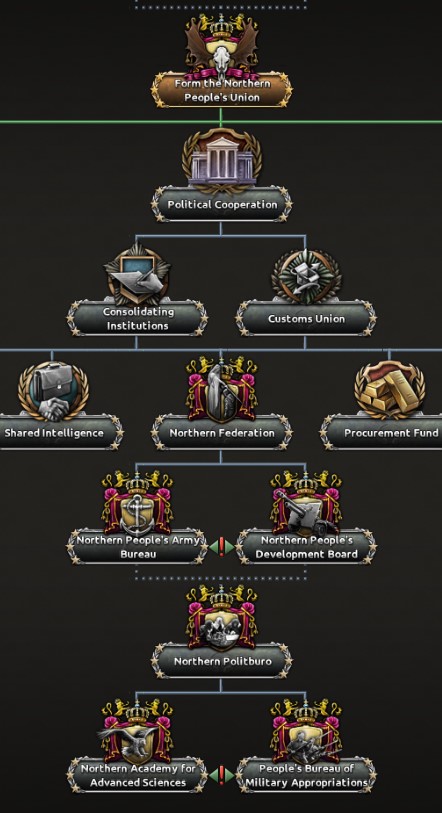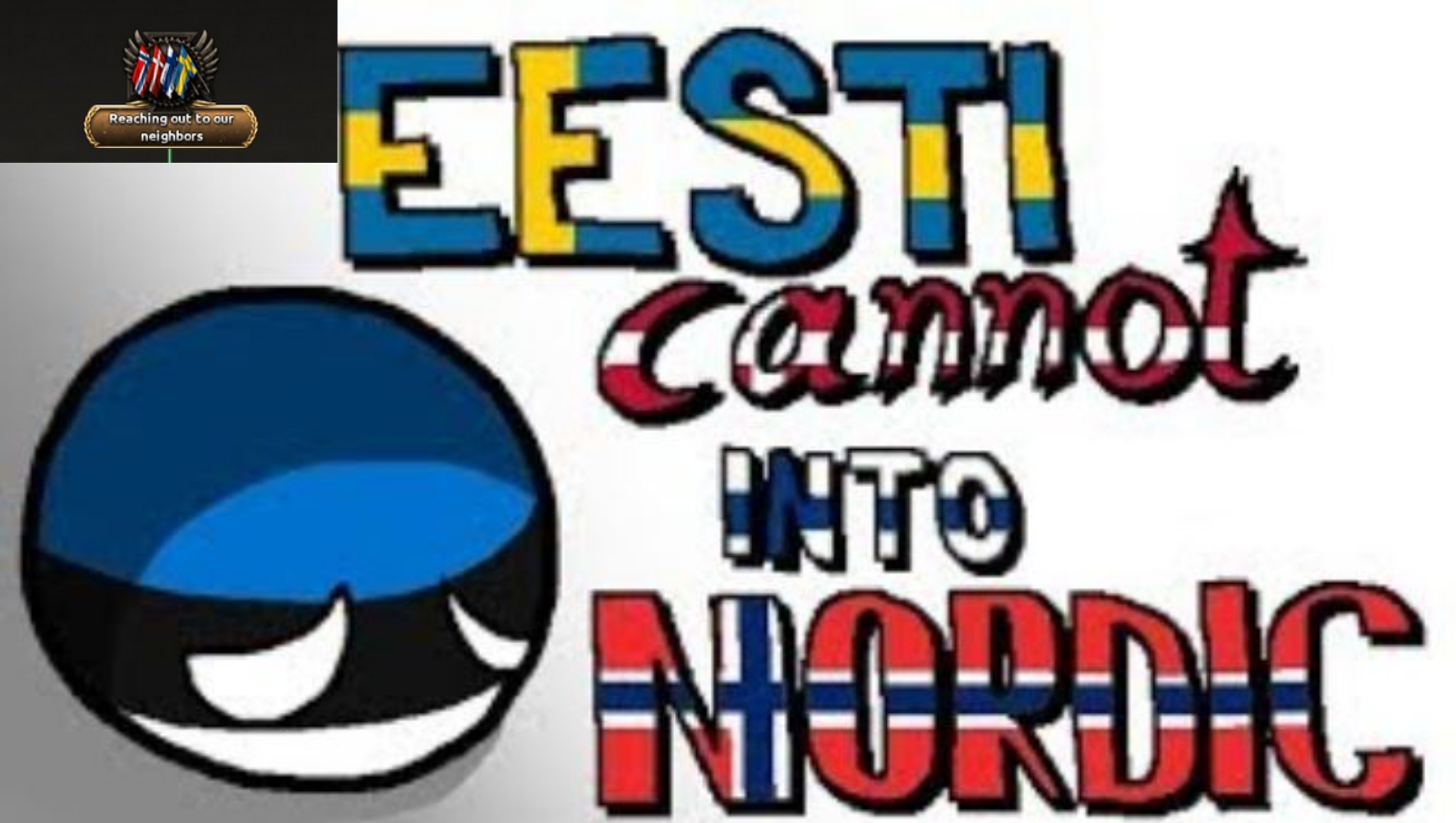Hej hei folks! Carlo here, and I’m super excited to present this new feature, probably the first to be made with multiplayer in mind. Just remember that this is all work in progress so you’ll definitely see stuff that will change for release.
Let me start with a hypothetical scenario:
You and your friends decide to play a co-op campaign of Hearts of Iron. You get your healthy snacks and drinks, jump into a voice chat and load the game, hoping to play as Monarchist Poland. There’s one problem though, one of your friends wants to play as monarchist Lithuania, and hopes to annex Poland and the other Baltic nations. If this has happened to you, then you’ll love the Joint Focus Tree. Actually I’m sure you’ll love it even if it hasn’t.
As nations that start the game disadvantaged against the big majors, a lot of minors rely on absorbing the countries around them to be able to compete. This happens with the Baltics, China, South America and importantly for us, the Nordic countries. We’re hoping the Joint Focus Tree will solve this by giving you and your friends the opportunity to collaborate with your neighbors and make your faction be more powerful than the sum of its parts, so you can take the fight to the Majors and win, TOGETHER!

But what is it? Well it’s a shared focus tree that Nordics will have in addition to the country’s normal focus tree, but when you start it you create a special faction where anyone can complete focuses in it, and they will complete in every relevant country, giving effects to all Nordic members of the faction.

Let’s take “Joint Military Exercises" as a very basic example. If Norway completes it, it’ll get 80 Army Experience and 2 75% Land Doctrine bonuses, but because it’s a Joint Focus, it will give 60 Army Experience and 2 50% Land Doctrine bonuses to every other Nordic in the faction.

The best part is that then another country, say, Denmark, can complete any focus that requires it while Norway does another focus, Joint or otherwise. You’re all working together and strengthening each other.

Other focuses give the Originator (The player that completed the focus) a special National Spirit that makes it the leader in that certain area, and because the requirements are pretty high, you will have to coordinate with your friends so each country specializes in one area to continue spreading the benefits around.

Now that I’ve explained the basic concept, let me describe how Arms Against Tyranny’s Joint Focus Tree will work:
If you’re playing as any of the Nordic countries and you’re not a puppet, you’ll eventually have the option of forming one of the three factions planned for this:
The Nordic Council: The Nordic democracies have joined forces to defend their political systems and to eradicate autocracy and oppression abroad (There’s currently an actual Nordic Council in real life, though with a different aim). They will use their resources and expertise to focus on quality over quantity, and manufacturing technologically advanced equipment, while still providing for their people.

The Northern People’s Union: The peoples of the North united against fascism and capitalism in Europe and beyond. Every worker that’s not making the tools of communism at home must take up arms and fight abroad. Expect superior numbers in both personnel and materiel

And finally, the Kalmar League: A mirror of the historical Kalmar Union, the monarchies and dictatorships of Scandinavia and Finland call upon their shared past to bring forth their common goal of domination, through armed conflict and conquest. By any means necessary.

As you can see, many of the icons, names and effects will change depending on which one fits your country’s current politics. Credit goes to Marie for her excellent art, there was a lot of back and forth to establish a unique visual identity for each faction, and they are some of my favorite focus icons in Hearts of Iron. Here’s some highlights

And you probably noticed the title background for these is different from normal ones, so stay tuned and we’ll talk about them and how you can change them yourself through modding.

Let us continue then. The JFT has 7 different branches: Airforce, Navy, Army, Civilian Production, Research, Military Production and, right in the middle, a political branch that will let you unlock institutions that improve and further customize your faction.
 For example, in the Communist faction, after establishing the Northern Federation, the faction’s National Spirit improves, and then you get something I call Capstone Selectors.
For example, in the Communist faction, after establishing the Northern Federation, the faction’s National Spirit improves, and then you get something I call Capstone Selectors.

When someone completes it, it will unlock 4 extra focuses at the end of the relevant branch. The first choice in the NPU is between the Army and Civilian Industry, and if we choose the Army one, 4 new focuses will appear at the end of the army branch, giving you an extra advantage on that area, and letting you adapt to the situation.

After that you can upgrade your faction again, and then you get another capstone choice, this time between Research and military production. Every one of these factions has 4 different configurations, depending on what you need, and how involved you want to be with it.

Before we finish, I want to show you what are those focuses before the one that lets you form the Joint Alliance. These are simple old shared focuses that all Nordics will have access to. They are meant to represent how they all helped each other in the period, while avoiding all out war with their neighbor’s aggressors. The best examples are Sweden, Norway and Denmark secretly sending volunteers and equipment to Finland to fend off the Soviet Union, and Sweden’s surreptitious support for Norwegian and Danish liberation against Germany. Of course with these focuses and decisions you’ll be able to go further than that and join them in their struggle, or even join their enemies and gain territory yourself.

Let’s dive in.
Reaching Out to Our Neighbors starts the decision category, and from the get go gives the option to promote Nordic Unity, letting you improve their opinion of you, especially handy if you want to form the Joint Faction with the AI.

Then you can go for Industrial Cooperation, which unlocks decisions to improve your economy and the economy of a neighbor in equal terms, if you go the other route, Leverage Nordic Investments, you can invest in other Nordics and ask them to invest in your, always with better terms for the initiator, but they’ll still get something out of it.

Mutual Guarantees is… Well… Mutual Guarantees. But Strengthen Ties is another useful one if you want to do the Joint Focus Tree, it not only makes your countries like each other more, but you’ll trade some party popularity, so if you’re communist, and they’re democratic, they will get some communism, and you’ll get some democracy, as a treat.

It concludes in the focus to form the alliance, but I want to draw your attention to the focuses on the sides. One has the name of the expansion (Mostly) and the other one is the Nordic March. They both let you send volunteers more easily and give you bonuses for combat but their goals are very different.

The TAAT focus unlocks several decisions that let you expand volunteer capacity, make it easier to send lend lease and even join the war, provided you’ve been involved in it enough participation in it. Every time you or any other Nordic helps them, the conflict scale increases, and the higher it is, the more likely your participation will go up, until your neighbor’s enemy sees you as a threat and attacks you too! It will be a balancing act for you to help your neighbors and not get invaded in the process.

And that’s it! This is how we plan to make the nations in this expansion work together more than ever, and introduce a new vessel for cool alt history. Obviously there’s tons more details that I didn’t include, but you can always ask me and I’ll try to answer where and when possible. Don’t forget to stay tuned for the next one of these, where Arheo will show you some diverse cool things!
Let me start with a hypothetical scenario:
You and your friends decide to play a co-op campaign of Hearts of Iron. You get your healthy snacks and drinks, jump into a voice chat and load the game, hoping to play as Monarchist Poland. There’s one problem though, one of your friends wants to play as monarchist Lithuania, and hopes to annex Poland and the other Baltic nations. If this has happened to you, then you’ll love the Joint Focus Tree. Actually I’m sure you’ll love it even if it hasn’t.
As nations that start the game disadvantaged against the big majors, a lot of minors rely on absorbing the countries around them to be able to compete. This happens with the Baltics, China, South America and importantly for us, the Nordic countries. We’re hoping the Joint Focus Tree will solve this by giving you and your friends the opportunity to collaborate with your neighbors and make your faction be more powerful than the sum of its parts, so you can take the fight to the Majors and win, TOGETHER!

But what is it? Well it’s a shared focus tree that Nordics will have in addition to the country’s normal focus tree, but when you start it you create a special faction where anyone can complete focuses in it, and they will complete in every relevant country, giving effects to all Nordic members of the faction.

Let’s take “Joint Military Exercises" as a very basic example. If Norway completes it, it’ll get 80 Army Experience and 2 75% Land Doctrine bonuses, but because it’s a Joint Focus, it will give 60 Army Experience and 2 50% Land Doctrine bonuses to every other Nordic in the faction.



If you’re playing as any of the Nordic countries and you’re not a puppet, you’ll eventually have the option of forming one of the three factions planned for this:
The Nordic Council: The Nordic democracies have joined forces to defend their political systems and to eradicate autocracy and oppression abroad (There’s currently an actual Nordic Council in real life, though with a different aim). They will use their resources and expertise to focus on quality over quantity, and manufacturing technologically advanced equipment, while still providing for their people.

The Northern People’s Union: The peoples of the North united against fascism and capitalism in Europe and beyond. Every worker that’s not making the tools of communism at home must take up arms and fight abroad. Expect superior numbers in both personnel and materiel








Reaching Out to Our Neighbors starts the decision category, and from the get go gives the option to promote Nordic Unity, letting you improve their opinion of you, especially handy if you want to form the Joint Faction with the AI.

Then you can go for Industrial Cooperation, which unlocks decisions to improve your economy and the economy of a neighbor in equal terms, if you go the other route, Leverage Nordic Investments, you can invest in other Nordics and ask them to invest in your, always with better terms for the initiator, but they’ll still get something out of it.







